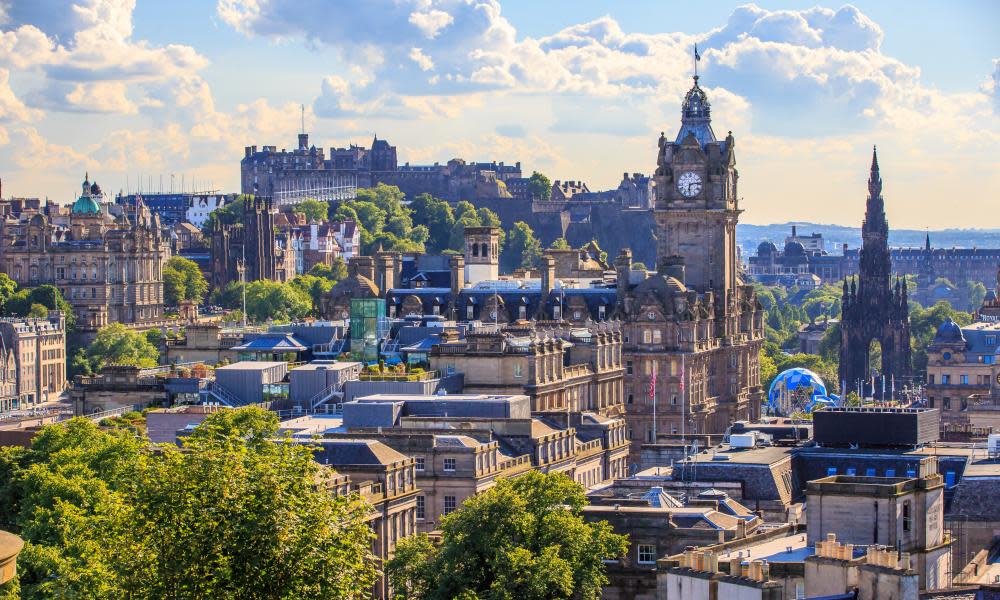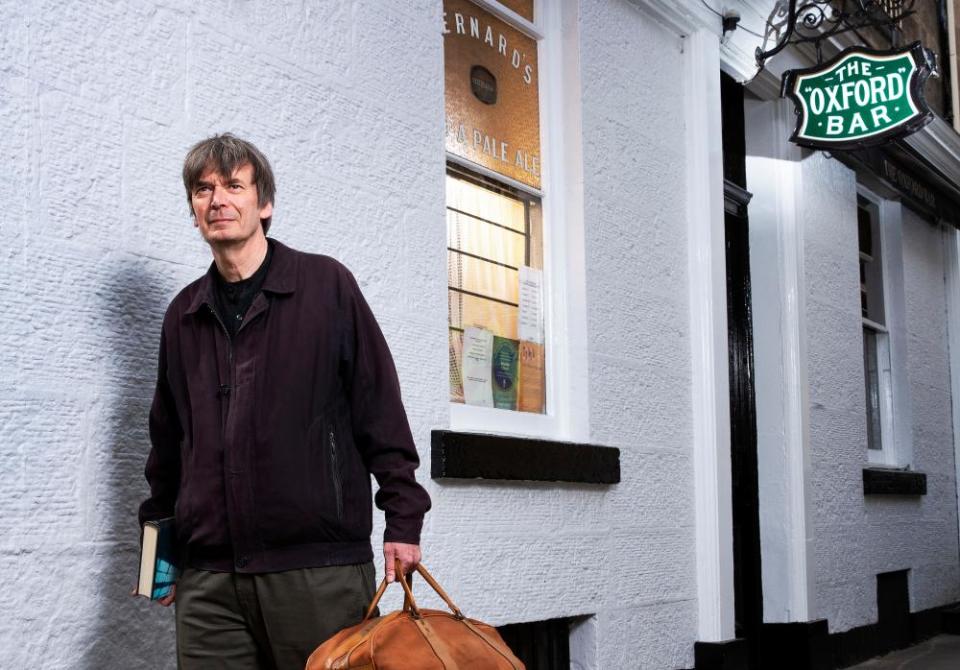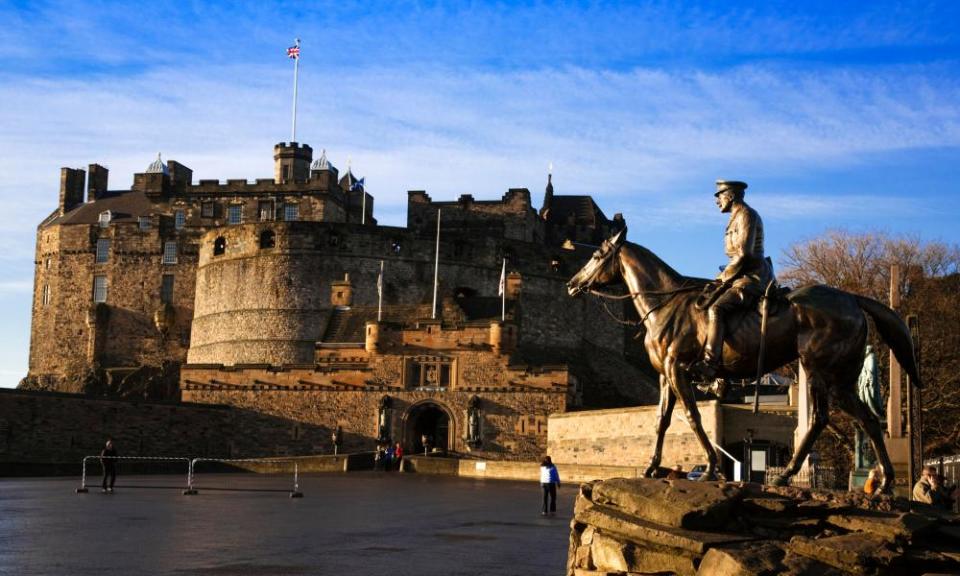‘With Edinburgh empty, we’re seeing our city through tourists’ eyes’

Edinburgh, of all British cities, is the most theatrical: the Cowgate arch; the march of crow-step gables up the Grassmarket; the great rake of the Royal Mile. All the city’s a stage, and all the men and women … well, where are they?
There is a feeling of waiting for the play to begin. Conditional plans are being made for Scottish tourism to reopen on 15 July, but visitor numbers in the capital are likely to be significantly down because the festivals have long been cancelled. But then again, this year will not see the usual summer exodus of residents escaping the festival crowds.
Meanwhile, lockdown Edinburgh is uncanny. Streets that should be busy with tourists, phones and raised voice are deserted. This invites a question: without visitors, what is this city like?

I walk from Waverley Station up Advocate’s Close, one of the steep medieval alleys that jut from the spine of the High Street. Carved into a stone lintel are words of comfort – He That Tholes Overcomes. “Thole” is the Scots word for endure. Though it dates from the 19th century, the message feels intended for our present moment.
Unable to leave Edinburgh over the past few months, many locals have found comfort in its weight of architecture, geology and history. With much else in flux, the city felt solid, dependable, familiar.
I look over the ramparts towards Princes Street and there’s no traffic. I feel a sense of awe that I had lost
Ian Rankin
Visitors have always gasped at its scale and grandeur, in particular the bristling swoosh of the skyline. Those who live here, used to this, grow to appreciate its minutiae: the hoppy stink of the breweries, the happy smell of the whins (gorse bushes); cherry blossom on Middle Meadow Walk; sunset on sandstone; the glimpsed firth, azure between tenements; cobbles underfoot, a castle overhead; the haar, the haar, the haar.
The present crisis has intensified such delights. “I’d fallen out of love with Edinburgh,” one woman told me. “Lockdown has changed that. Every day, something lifts me up: the view from Arthur’s Seat, lying in the sun on Calton Hill, biking to Portobello, the evening light.”

There are new sounds, too – or, rather, old sounds audible once more. Birdsong in Victoria Street. The roar of lions in the zoo, no longer out-roared by cars on Corstorphine Roa.
“It has sharpened people’s ears,” observes the novelist Ian Rankin, whose eerie photographs on Twitter of empty streets have been a shivery lockdown delight. “And it has opened our eyes to what the city is. I’ve been investigating all these wee closes down the High Street. I’ve found bits of Edinburgh I didn’t know existed.”
We meet in Makars’ Court, just outside the Writers’ Museum. Set into the flagstones of the courtyard are quotations by famous Edinburgh authors. Muriel Spark’s is “The Transfiguration of the Commonplace” – pretty much the theme of any walk through the city at the moment.
“I’m seeing Edinburgh differently,” Rankin says. “It’s like being a tourist and seeing it for the first time. Walk up to the Castle Esplanade and there’s nobody there; look over the ramparts towards Princes Street and there’s no traffic – I feel a sense of awe that I had lost.”
The city is taking a deep breath, and it may not be a bad thing if tourism comes back on a smaller scale
Robin Mitchell
He leads the way up the Miss Jean Brodie Steps, which connect the Grassmarket with Lauriston Place. One of the best views of the castle, he promises, is from this pathway. He’s right: it’s magnificent. Edinburgh folk are to be admired for their refusal to become jaded about the citadel in their midst. The trick is to develop a favourite perspective of one’s own – glimpsing it, for instance, from the top deck of a certain bus cresting a certain rise at a certain golden hour. “The person who is tired of Edinburgh,” Rankin smiles, paraphrasing Dr Johnson, “is tired of life.”
Some 525,000 people live in Edinburgh. More than four million visit “Edinburgh” each year. The two cities – one real, one conjured – are imperfectly overlaid, causing chafing, friction, irritation. Edinburgh has been named one of the world’s worst overtourism hotspots. In August, in normal times, the historic centre becomes uncomfortably crowded, locals grumble about “festivalisation”, and express frustration that the city is not run for its citizens. No one would have wished for a health crisis to crash the money machine, but this is an opportunity to see the place clearly in a way that hasn’t been possible for years. It is a chance for Edinburgh and Edinburghers to renew their vows.

Robin Mitchell runs Cadies & Witchery Tours. This will be the first summer since 1985 that he won’t be leading walking groups to scenes of reputed hauntings and historic gruesomeness. While acknowledging the disaster for the Edinburgh and Scottish economy, he is looking forward to a calmer August: “The city is taking a deep breath, and it may not be a bad thing if tourism comes back on a smaller scale.”
He has been spending these strange, slow days in Greyfriars Kirkyard. Usually, this ancient churchyard is very busy. It is on the Harry Potter pilgrimage trail (JK Rowling is said to have named characters after people buried here) and is the focus of one of Edinburgh’s best-loved stories: that of Greyfriars Bobby, the faithful terrier who slept on his master’s grave. Tourists had taken to rubbing – for luck – the nose of the statue of Bobby, but this tradition has, of late, gone into steep decline. Nobody wants to catch Covid-19 from a wee bronze dug.
Without the crowds, and with a new delicious loneliness, Greyfriars is revealed as extraordinary: soot-stained stones hoaching with skulls, beasts, screaming demons. If you have a taste for the gothic, if you are a goth with taste, this is the place for you.
We take a turn among the tombs then walk back out on to the empty streets. Here is Edinburgh as she has not been seen for decades. No fireworks or fire-eaters, no stag dos or silent discos – just a beautiful old town and the people who love her best.
“This is an absolute gift,” Mitchell says. “We’re experiencing something we may never experience again.”


